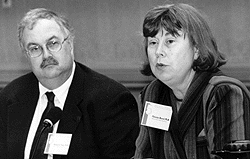 Linda Kaplan of the National Association of Alcoholism and Drug Abuse Counselors.
Linda Kaplan of the National Association of Alcoholism and Drug Abuse Counselors.The need to translate research findings into effective drug abuse prevention and treatment programs was the common thread that wove its way through NIDA's Fifth Annual Constituent Conference in December in Lansdowne, Virginia. Representatives from 48 national organizations met with more than 30 of NIDA's top staff to learn of new NIDA programs, provide feedback on current programs, and help set NIDA's research agenda for the coming years.
The Constituent Conference is one way in which NIDA communicates with organizations concerned with drug abuse. At each annual meeting, NIDA presents its latest research findings and other information to the field, while constituent leaders voice their most pressing concerns and recommendations to the Institute.
Each year, NIDA prepares a "report card" that illustrates how the Institute has acted in response to the organizations' recommendations from the preceding year. (See "NIDA's Report Card".) A new element for the 1998 conference, in response to a constituent recommendation at the 1997 conference, was the compilation of a "report card" by the constituent organizations, which also was distributed at the meeting. The report summarized each organization's activities over the past year in research dissemination, collaboration with NIDA and other organizations, and joint projects with other members of the drug abuse research and service delivery communities.
 Dr. Gilbert Parks of the National Medical Association (left) and Dr. Charles O'Brien of the American College of Neuropsychopharmacology.
Dr. Gilbert Parks of the National Medical Association (left) and Dr. Charles O'Brien of the American College of Neuropsychopharmacology.NIDA Director Dr. Alan I. Leshner described the Institute's goals for the future."Our primary goal is to significantly advance drug abuse and addiction prevention and treatment," he said. "We will be exploring nicotine addiction and the current methamphetamine epidemic, as well as the genetic and environmental factors that make some people more likely than others to abuse drugs.
"Development and testing of new treatments for drug addiction is a major priority," Dr. Leshner continued. "Effective treatment will address the biology, behavior, and social context of drug use, resulting in a whole- approach. We must move treatments from the laboratory to practice and determine which ones work in real-life settings. To accomplish this, NIDA will establish a national drug abuse treatment clinical trials network." (See "Clinical Trials Network Will Speed the Testing and Delivery of New Drug Abuse Therapies".)
 Dr. Richard Yoast of the American Medical Association (left) and Dr. Christine Hartel of the American Psychological Association.
Dr. Richard Yoast of the American Medical Association (left) and Dr. Christine Hartel of the American Psychological Association.To develop recommendations for NIDA priorities in the coming year, participants split into work groups to discuss three program areas: AIDS and other health consequences of drug addiction; NIDA activities in addiction treatment; and vulnerability and pathways to drug addiction. Group members considered three key questions for each topic:
- How can this research better influence the delivery of drug abuse services?
- What other products and research are needed by the field?
- How can NIDA disseminate these research findings to the field?
In a concluding panel discussion, constituent group leaders noted that a key element in influencing policy and decisionmaking is translating NIDA research so that the public can understand that drug abuse is a chronic, relapsing disease. If drug addiction is presented as the disease that it is, the stigma associated with it will decrease, the panel members agreed. NIDA and its constituents must translate the research for the public so that the public will be better informed about drug abuse treatment and prevention initiatives, the panel concluded.
